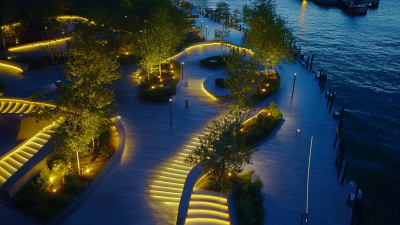Edison LED Lighting
Projects
Illuminate Your Space: The Science Behind LED Down Lights and Their Energy Efficiency Benefits
In recent years, the demand for energy-efficient lighting solutions has surged, with LED down lights emerging as a frontrunner in this evolution. According to a report by the U.S. Department of Energy, LED lighting can use up to 75% less energy than traditional incandescent bulbs, significantly reducing both energy bills and carbon footprints. Furthermore, the lifespan of LED down lights can exceed 25,000 hours, showcasing their durability and low maintenance requirements. This transition to LED technology not only enhances the aesthetic appeal of interiors through improved illumination but also aligns with global sustainability goals. As more businesses and homeowners seek effective ways to enhance their spaces while minimizing environmental impact, understanding the science behind LED down lights becomes crucial. Exploring their energy efficiency benefits reveals how they can transform our lighting approach for a more sustainable future.

Understanding LED Down Lights: What You Need to Know
LED down lights have become a popular choice for both residential and commercial spaces due to their impressive energy efficiency and longevity. Unlike traditional incandescent bulbs, which convert only about 10% of energy into light, LED down lights utilize about 80-90% of their energy to produce illumination, significantly reducing electricity consumption. According to the U.S. Department of Energy, switching to LED lighting can save up to 75% in energy costs and has the potential to reduce greenhouse gas emissions greatly.
When choosing LED down lights, consider the color temperature that best suits your environment. For instance, a cooler white light (5000K-6500K) is ideal for kitchens or workspaces, while warmer light (2700K-3000K) is perfect for bedrooms and living areas, creating a cozy atmosphere.
Tips: Always check the lumens rating of the LED down light to ensure it offers adequate brightness for your needs. Additionally, look for ENERGY STAR certified products, as they meet strict efficiency standards and perform better than standard models. Researching the lifespan of different LED brands can also guide your purchase, as high-quality LED down lights can last over 25,000 hours, providing long-term savings and reducing the need for frequent replacements.
Exploring the Energy Efficiency of LED Technology
 LED technology has revolutionized the way we illuminate our spaces, offering remarkable energy efficiency benefits over traditional lighting options. LED down lights consume significantly less energy, which translates into lower electricity bills and a reduced carbon footprint. Unlike incandescent bulbs that waste a large portion of energy as heat, LEDs convert most of their energy into light, making them an excellent choice for both residential and commercial applications. With a lifespan that can exceed 25,000 hours, LED lights also minimize the frequency of replacements, further contributing to energy savings and resource conservation.
LED technology has revolutionized the way we illuminate our spaces, offering remarkable energy efficiency benefits over traditional lighting options. LED down lights consume significantly less energy, which translates into lower electricity bills and a reduced carbon footprint. Unlike incandescent bulbs that waste a large portion of energy as heat, LEDs convert most of their energy into light, making them an excellent choice for both residential and commercial applications. With a lifespan that can exceed 25,000 hours, LED lights also minimize the frequency of replacements, further contributing to energy savings and resource conservation.
Tips for Maximizing LED Energy Efficiency:
- Utilize dimmable LED down lights to adjust brightness based on your needs, reducing energy consumption during less active times.
- Consider smart lighting solutions that allow for programmable schedules and motion sensors, ensuring lights are only on when needed.
- Opt for fixtures with higher lumens per watt ratings to ensure you’re getting the maximum light output for the least amount of energy used.
By making informed choices about LED down lights and their applications, you can enhance your space's ambiance while enjoying the numerous energy efficiency benefits they offer.
Comparing LED Down Lights with Traditional Lighting Options
When comparing LED down lights with traditional lighting options, it's essential to understand the fundamental differences in technology and efficiency. Traditional incandescent bulbs typically convert only about 10% of their energy into visible light, with the remaining 90% wasted as heat. This inefficiency results in higher energy consumption and increased electricity costs for homeowners and businesses alike. In contrast, LED down lights operate using a much more efficient mechanism, converting approximately 80-90% of their energy into light. This dramatic difference not only reduces energy bills but also decreases the need for frequent replacements due to the longer lifespan of LEDs.
Furthermore, the color quality and brightness of LED down lights surpass traditional options. While incandescent bulbs offer warm light, they struggle with color rendering and can cause eye strain in poorly lit areas. LED technology provides better color accuracy and can be adjusted to produce various color temperatures, enhancing the ambiance of any space. Additionally, the minimal heat output of LEDs contributes to an overall cooler environment, making them a safer alternative, particularly in residential settings. As energy efficiency becomes increasingly important in a world focused on sustainability, LED down lights emerge as a clear choice over traditional lighting methods.
Installation Tips for Maximizing LED Down Light Performance
When installing LED down lights, proper placement is crucial for maximizing both performance and energy efficiency. Begin by assessing the layout of the room to determine optimal spacing and positioning. A general rule of thumb is to space the down lights approximately 4 to 6 feet apart, which helps to ensure even light distribution and minimizes shadows. Consider the height of the ceiling, as this will influence how far apart the fixtures should be. In higher ceilings, you may need to increase the spacing to ensure adequate illumination.
It's also essential to select the right wattage and color temperature to suit the environment. Warmer tones (2700K-3000K) are ideal for creating a cozy atmosphere in living spaces, while cooler tones (4000K-5000K) work best in work areas like kitchens and offices. Additionally, installing dimmer switches can further enhance LED down light performance by allowing you to adjust brightness based on different activities and times of day. Proper installation not only improves aesthetic appeal but also contributes to significant energy savings, making LED down lights an excellent choice for any space.
Maintenance and Longevity: Keeping Your LED Lights Bright
Maintaining the brightness of LED down lights is crucial for ensuring consistent illumination and minimizing replacement costs over time. One of the key factors in their longevity is the quality of the materials used in their construction. Opting for high-quality LED products can significantly reduce the frequency of maintenance as they tend to have better heat dissipation properties, which prevents overheating and prolongs their lifespan. Regularly cleaning the light fixtures also plays a vital role; dust and debris can accumulate, diminishing light output and creating hotspots that may lead to premature failure.

In addition to proper maintenance, it’s essential to consider the operating environment of LED down lights. Ensuring adequate ventilation around the fixtures can enhance their performance and longevity. Furthermore, utilizing dimmers can help regulate power consumption, allowing users to tailor brightness levels based on their needs while extending the life of the bulbs. By combining quality products with effective maintenance practices, users can enjoy bright, efficient lighting for years to come, making LED down lights a smart investment for both residential and commercial spaces.
Related Posts
-

What is the Future of Best LED Down Lights? Insights and Trends for Global Buyers
-

Unlocking the Benefits: A Guide to Sourcing Premier LED Lighting Solutions for Your Business
-

Challenges in Sourcing Quality Led Ceiling Lights for Your Business
-

Navigating Tariffs and Embracing Growth in Chinese Manufacturing of Best Office Lighting Solutions
-

Crafting Global Trust Through Unmatched Quality: The Rise of Chinese Shop Lighting
-

Unlocking the Potential of Landscape Lighting for Sustainable Outdoor Spaces Worldwide
